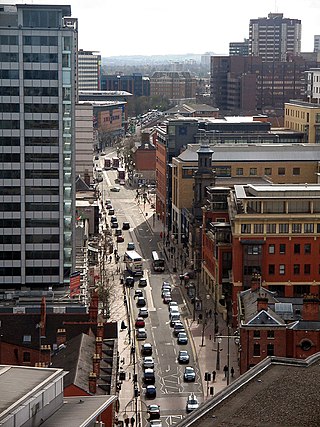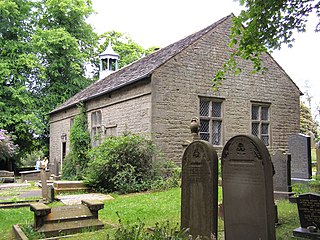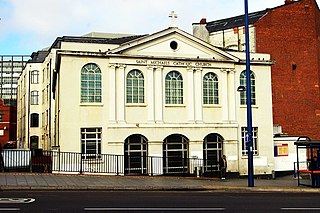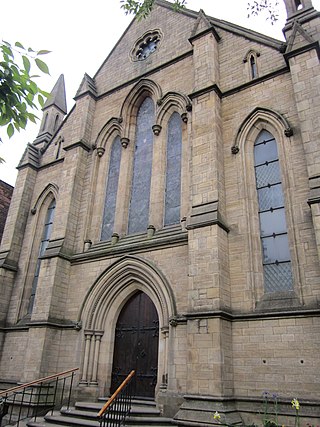
Broad Street is a major thoroughfare and popular nightspot centre in Central Birmingham, England. Traditionally, Broad Street was considered to be outside Birmingham City Centre, but as the city centre expanded with the removal of the Inner Ring Road, Broad Street has been incorporated into the new Westside district of the city centre due to its position within the A4540 road.
The General Assembly of Unitarian and Free Christian Churches is the umbrella organisation for Unitarian, Free Christians, and other liberal religious congregations in the United Kingdom and Ireland. It was formed in 1928, with denominational roots going back to the Great Ejection of 1662. Its headquarters is Essex Hall in central London, on the site of the first avowedly Unitarian chapel in England, set up in 1774.

King's Chapel is an American independent Christian unitarian congregation affiliated with the Unitarian Universalist Association that is "unitarian Christian in theology, Anglican in worship, and congregational in governance." It is housed in what was for a time after the Revolution called the "Stone Chapel", an 18th-century structure at the corner of Tremont Street and School Street in Boston, Massachusetts. The chapel building, completed in 1754, is one of the finest designs of the noted colonial architect Peter Harrison, and was designated a National Historic Landmark in 1960 for its architectural significance. The congregation has worshipped according to a Unitarian version of the Book of Common Prayer since 1785, currently in its ninth edition.

Theophilus Lindsey was an English theologian and clergyman who founded the first avowedly Unitarian congregation in the country, at Essex Street Chapel. Lindsey's 1774 revised prayer book based on Samuel Clarke's alterations to the 1662 Book of Common Prayer inspired over a dozen similar revisions in the succeeding decades, including the prayer book still used by the United States' first Unitarian congregation at King's Chapel, Boston.
Joseph Wharton was a successful American merchant, and the owner of "Walnut Grove," a country place on Fifth street, near Washington Avenue, Philadelphia, in which the Mischianza of 1778 was held. The house was the finest of its day near that city. It was torn down in 1862, to make room for a schoolhouse. He was called "Duke Wharton", because of his stately bearing.

William Russell was a practical Christian, a practising Unitarian, a Birmingham merchant and a close friend and sponsor of Joseph Priestley, who helped agitate against penal laws affecting English Dissenters and canvassed for a national political union.

Rivington Unitarian Chapel is an active place of Unitarian worship in Rivington, Lancashire, England. It was founded in 1703, although its congregation dates to 1667. It is designated as a Grade II* listed building with some restoration in 1990, and hs ongoing preservation.

The Second Congregational Church in New York, organized in 1825, was a Unitarian congregation which had three permanent homes in Manhattan, New York City, the second of which became a theater after they left it. In 1919 the congregation joined the Community Church Movement and changed its name to Community Church of New York. The same year, its church building on 34th Street was damaged by fire. From 1948 until 2022, the congregation was housed at 40 East 35th Street. As of 2024, the church offices are located on East 35th Street and services are held at the neighboring Church of the Incarnation. The Community Church of New York is a member of the Unitarian Universalist Association.

Samuel Bache was an English Unitarian minister.

Fulwood Old Chapel is a Unitarian place of worship in the Fulwood district of western Sheffield, South Yorkshire. It is a member of the General Assembly of Unitarian and Free Christian Churches, the umbrella organisation for British Unitarians.

St Michael's Catholic Church is a Catholic church located on Moor Street in Birmingham, England. It received Grade II listed building status on 25 April 1952.

The Octagon Chapel, Liverpool, was a nonconformist church in Liverpool, England, opened in 1763. It was founded by local congregations, those of Benn's Garden and Kaye Street chapels. The aim was to use a non-sectarian liturgy; Thomas Bentley was a major figure in founding the chapel, and had a hand in the liturgy.
James Yates was an English Unitarian minister and scholar, known as an antiquary.

The Unitarian Universalist Church of Buffalo is an historic church complex located at 695 Elmwood Avenue, in Buffalo, New York. The building was designed by architect Edward Austin Kent in 1906. Kent died in 1912 aboard the RMS Titanic and a memorial plaque is located in the church honoring him.

Mansfield Road Baptist Church is a Baptist church in Nottingham, England, UK. It is affiliated with the Baptist Union of Great Britain.
The Gravel Pit Chapel was established in 1715–1716 in Hackney, then just outside London, for a Nonconformist congregation, which by the early 19th century began to identify itself as Unitarian. In 1809 the congregation moved to the New Gravel Pit Chapel nearby, while its old premises were taken over by Congregationalists. The New Gravel Pit Chapel was closed and demolished in1969.

The Church of the Saviour in Edward Street, Birmingham, was a liberal Unitarian church founded in 1845 for the liberal nonconformist preacher, George Dawson. It became the centre of the programme of social and municipal improvement known as the Civic Gospel, and was instrumental in launching Joseph Chamberlain's political career.

Bank Street Unitarian Chapel is a Unitarian place of worship in Bolton, Greater Manchester, England.

Gellionnen Chapel is a Unitarian place of worship near Pontardawe, South Wales, United Kingdom. The chapel was first built in 1692 by Protestant dissenters, becoming Unitarian in the late 18th century. It is a member of the General Assembly of Unitarian and Free Christian Churches, the umbrella body for British Unitarians. Gellionnen Chapel is the oldest Dissenting chapel in the Swansea Valley, is one of the oldest surviving chapels in the region and is a Grade II* listed building.
















